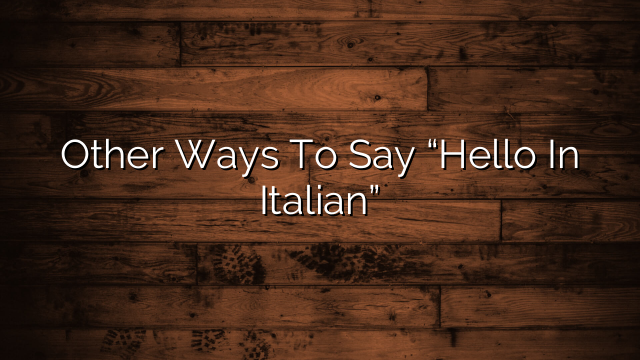Did you know that Italian is one of the most widely spoken languages in the world? With over 85 million speakers, it is not only the official language of Italy but also holds official status in Switzerland, San Marino, and Vatican City.
If you’re planning a trip to Italy or simply have an interest in learning this beautiful language, it’s important to know how to greet people properly. In this article, we will explore other ways to say ‘hello’ in Italian beyond the commonly known ‘ciao.’
By familiarizing yourself with greetings such as ‘buongiorno,’ ‘salve,’ and ‘buonasera,’ you can enhance your cultural understanding and make a positive impression on Italian-speaking individuals. Additionally, we will discuss expressions like ‘ciao bella/o’ and ‘come stai?’ which are commonly used among friends or acquaintances.
So let’s delve into these alternative greetings and enrich our linguistic repertoire!
Key Takeaways
- Italian is one of the most widely spoken languages in the world with over 85 million speakers.
- Learning how to greet people properly in Italian is important for cultural understanding.
- Common Italian greetings include ‘Ciao’, ‘Buongiorno’, ‘Buonasera’, ‘Buonanotte’, and ‘Salve’.
- Greetings in Italian reflect values of warmth, hospitality, and politeness.
Buongiorno
Buongiorno is the standard and most commonly used greeting in Italian, particularly in formal settings. It is a versatile greeting that can be used throughout the day, from morning until early afternoon. Other common Italian greetings for different times of the day include ‘buonasera’ (good evening) and ‘buonanotte’ (goodnight).
To properly pronounce ‘buongiorno’ in Italian, one must emphasize the first syllable with an elongated ‘oo’ sound, followed by a short ‘n’. The second part of the word consists of ‘gior’, pronounced as ‘jor’ with a soft ‘g’. Finally, the last syllable is pronounced as ‘no’, similar to how it would sound in English.
Understanding these common Italian greetings and their proper pronunciation allows individuals to effectively communicate and greet others in various social situations throughout the day.
Salve
Salve, an elegant verbal gesture, serves as a gateway to the Italian language, encapsulating the essence of cordiality and formality when initiating a conversation.
In addition to ‘Buongiorno’, ‘Salve’ is commonly used as a greeting in Italy.
It is worth noting that different regions of Italy have their own unique greetings. For instance, in Southern Italy, it is common to hear ‘Bongiorno’ instead of ‘Buongiorno’. This highlights the rich diversity within Italian culture and the importance placed on greetings as a way of showing respect and establishing social connections.
Greetings are not simply perfunctory exchanges but rather a reflection of Italian values such as warmth, hospitality, and politeness.
Understanding the nuances of these greetings allows individuals to fully immerse themselves in the richness of Italian culture.
Buonasera
In Italian culture, there is a commonly used greeting known as ‘Buonasera,’ which serves as an elegant verbal gesture to initiate conversations with cordiality and formality.
‘Buonasera’ is typically used in the evening or late afternoon, when it translates to ‘good evening’ in English.
It is important to understand how to use ‘buonasera’ in different contexts. For instance, when entering a room or meeting someone for the first time, it is customary to greet them with a warm ‘buonasera.’
Additionally, it is essential to follow certain etiquette tips when using ‘buonasera’ in Italian greetings. These include maintaining eye contact while saying the greeting, using a respectful tone of voice, and offering a firm handshake if appropriate.
Overall, ‘buonasera’ serves as an integral part of Italian culture and communication etiquette.
Ciao bella/o
The phrase ‘Ciao bella/o’ is a common informal greeting in Italian that is often used to address someone in a friendly and familiar manner. It is commonly used among friends, family members, or acquaintances. However, it is important to note that this greeting should be used with caution in more formal or professional settings, as it may come across as too casual.
In addition to ‘Ciao bella/o,’ there are several other common greetings in Italian for different times of the day. For example, ‘Buongiorno’ is used in the morning until around noon, ‘Buonasera’ is used in the evening, and ‘Buonanotte’ is used before going to bed.
Understanding when and how to use these different greetings appropriately can help individuals navigate social interactions in Italy effectively.
Come stai?
One common phrase used in Italian to inquire about someone’s well-being is ‘Come stai?’ This phrase, which translates to ‘How are you?’ in English, is a simple yet effective way of initiating a conversation and showing concern for the other person’s welfare.
When asked ‘Come stai?’, it is customary to respond with an honest assessment of one’s emotional or physical state. Common responses include ‘Bene’ (well), ‘Male’ (bad), or ‘Così così’ (so-so).
It should be noted that Italians often engage in more elaborate greetings beyond ‘Come stai?’. For example, they may say ‘Buongiorno’ (good morning) or ‘Buonasera’ (good evening) as a general greeting without explicitly asking about one’s well-being. These greetings reflect the Italian culture’s emphasis on warmth and connection in social interactions.
Frequently Asked Questions
What are some informal ways to say hello in Italian?
Informal greetings in Italian offer a diverse range of expressions that convey familiarity and warmth. These include "Ciao," which is widely used among friends and acquaintances, "Salve," which is more formal but still friendly, and "Buongiorno," commonly used in the morning.
Are there any regional variations in greetings in Italy?
Regional variations in Italian greetings exist, with different informal greetings used across Italy. These variations reflect the diverse cultural and linguistic traditions within the country. Understanding these regional differences enhances one’s ability to communicate effectively in different parts of Italy.
Can I use ‘Buongiorno’ at any time of the day?
In Italian, the greeting "buongiorno" is typically used in the morning and it translates to "good morning." In the afternoon, Italians commonly use "buon pomeriggio" which means "good afternoon." The formality of the greeting may vary depending on one’s familiarity with the person.
Is it considered impolite to use ‘Ciao bella/o’ with strangers?
Using ‘ciao bella/o’ with friends is considered appropriate in Italian culture. However, it may be perceived as impolite when used with strangers. To greet someone respectfully in Italian, it is recommended to use formal greetings like ‘buongiorno’ or ‘buonasera’.
Are there any cultural norms or etiquette associated with greetings in Italy?
Cultural norms associated with greetings in Italy encompass various aspects. Italians place importance on polite and respectful interactions, particularly with elders. Greeting elders in Italian culture is often done by using formal titles or honorifics to show respect and deference.
Conclusion
In the Italian language, there are various ways to greet someone.
One can say ‘Buongiorno’ to wish someone a good morning, ‘Salve’ as a formal and general greeting, or ‘Buonasera’ to wish someone a good evening.
Another common way is to simply say ‘Ciao bella/o,’ which means hello beautiful/handsome.
Additionally, one can ask ‘Come stai?’ meaning how are you.
These greetings reflect the warmth and friendliness of the Italian culture, making interactions more pleasant and engaging.
It is always delightful to exchange pleasantries with others in their native language, creating an instant connection and fostering a sense of inclusivity.



